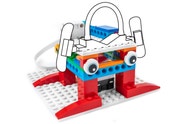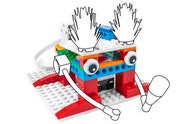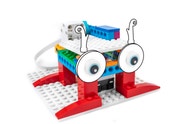SPIKE™ Essential
Rubbish Monster Machine
Help Sofie create a new way for her friends to throw out their rubbish.
30-45 min.
Beginner
Years 3-5

Prepare
- Review the Rubbish Monster Machine lesson in the LEGO® Education SPIKE™ App.
- If you feel that it would be beneficial, pre-teach these related vocabulary words: modify, parameter, react and tedious.
- Consider the abilities and backgrounds of all your pupils. Differentiate the lesson to make it accessible to everyone. Please refer to the Differentiation section below for suggestions on how to do this.
- If time permits, plan and facilitate the language arts extension. Please refer to the Extension section below for further information.
Engage
(Whole Class, 5 Minutes)
- Facilitate a quick discussion about using an automated solution to complete a tedious task.
- Talk with your pupils about throwing out the rubbish at home or at school.
- Ask questions like these: How could you improve the rubbish bin? What could you improve about how you throw out your rubbish?
- Introduce your pupils to the story’s main characters and the first challenge: making the rubbish-eating monster react to the blue ‘rubbish’.
- Distribute a brick set and a device to each group.
Explore
(Small Groups, 30 Minutes)
- Have your pupils use the LEGO® Education SPIKE™ App to guide them through their first challenge:
- Create and test the program that makes the rubbish-eating monster react to the blue ‘rubbish’.
- Have your pupils iterate and test their models to complete the next two challenges in the app:
- Upgrade the program to react to different-coloured ‘rubbish’.
- Design your own improved rubbish-eating monster.
- You can find coding and building help in the Tips section below.
Explain
(Whole Class, 5 Minutes)
- Gather your pupils together to reflect on their completed challenges.
- Ask questions like these: How did you program Sofie’s rubbish-eating monster to react to the different-coloured ‘rubbish’? How did you upgrade Sofie’s rubbish-eating monster?
Elaborate
(Whole Class, 5 Minutes)
- Prompt your pupils to discuss and reflect on the process of automating a prototype in order to complete a tedious task.
- Ask questions like these: Why do you think it's beneficial to have a robot repeat a tedious task? Can you think of another task that you could automate in order to make it more interesting?
- Have your pupils tidy up their workstations.
Evaluate
(Ongoing Throughout the Lesson)
- Ask guiding questions to encourage your pupils to ‘think aloud’ and explain their thought processes and reasoning in the decisions they’ve made while building and programming their models.
Observation Checklist
- Measure your pupils’ proficiency in creating and refining automated solutions.
- Establish a scale that suits your needs. For example:
- Requires additional support
- Can work independently
- Can teach others
Self-Assessment
Have each pupil choose the brick that they feel best represents their performance.
- Yellow: I think that I can create and refine an automated solution.
- Blue: I can create and refine an automated solution.
- Green: I can create and refine an automated solution, and I can also
help a friend to do it.
Peer Feedback
- In their small groups, have your pupils discuss their experiences of working together.
- Encourage them to use statements like these:
- I liked it when you…
- I'd like to hear more about how you…
Tips
Coding Tips
- After your pupils have completed their first challenge, they'll be provided with three Inspiration Coding Blocks, which will help them to modify their programs.
- The Inspiration Coding Blocks are intended to spark their imaginations as they experiment to find their own solutions.




Model Tip
- After your pupils have completed their second challenge, they’ll be provided with three Inspiration Images and an open-ended prompt, which will help them to improve their models.
- The Inspiration Images are meant to help spark their imaginations as they experiment and personalise their models.




There are no specific building instructions for this challenge.
Differentiation
Simplify this lesson by:
- Selecting one Inspiration Image to help your pupils personalise their models
- Experimenting with either the coding or the building
Increase the difficulty by:
- Programming four unique reactions to bricks of four different colours
- Exploring new and different Coding Blocks in the program
Extension
- Have your pupils conduct a short research project comparing how two different countries sort and dispose of their rubbish.
If facilitated, this will extend beyond the 45-minute lesson.
Language Arts: National Curriculum English En5/3.3 Composition b
Teacher Support
The pupils will:
- Explore the benefits of automated solutions
- Refine a prototype as part of a cyclical design process
- Engage effectively in a range of collaborative discussions
(one for every two pupils)
- LEGO® Education SPIKETM Essential Set
- Device with the LEGO® Education SPIKE™ App installed
National Curriculum
Computing
Co2/1.2
- use sequence, selection, and repetition in programs; work with variables and various forms of input and output
Design and Technology
DT2/1.4b
- understand and use mechanical systems in their products
DT2/1.4d - apply their understanding of computing to programme, monitor and control their products.
English
En5/1g
- use spoken language to develop understanding through speculating, hypothesising, imagining and exploring ideas
En5/3.3b
Draft and write by: - selecting appropriate grammar and vocabulary, understanding how such choices can change and enhance meaning
- in narratives, describing settings, characters and atmosphere and integrating dialogue to convey character and advance the action
- précising longer passages
- using a wide range of devices to build cohesion within and across paragraphs
- using further organisational and presentational devices to structure text and to guide the reader




